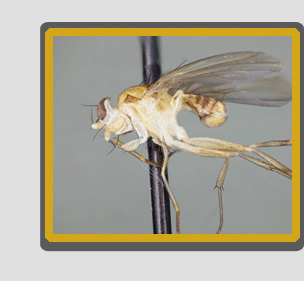

Characteristics
Sobarocephala lachnosternum is not strikingly different from other Nearctic Sobarocephala, although the gena is relatively high (about as high as the first flagellomere), and the epandrium is large and barrel-shaped (see figure to right). The thorax is yellow, excluding a large quadrate spot on the notopleuron in most specimens, the legs are only brown on the fore tarsi and the abdomen has brown markings restricted to tergites 3 to 5 (or 6).
Similar species
Sobarocephala lachnosternum is lightly pigmented like most Sobarocephala, and can easily be mistaken for a number of other species - S. setipes in particular. Males can be identified by the size of the epandrium, however, and females can be identified by their abdominal pattern (tergites 3, 4 and 6 are largely or entirely brown and tergite 5 has a narrow central stripe).
Distribution
This species is found with relative frequency throughout much of northeastern North America, but specimens have also been collected in Saskatchewan, Utah and Texas, suggesting that we know little about the western distribution of this species.
Biology
Sobarocephala lachnosternum has been collected using Malaise and sticky traps, and has been found at marsh edges, in sedges, in grass under Betula and Populus, in hemlock/hardwood, boreal mixedwood and Acer/Betula forests.
Most of the type series was reared from larvae collected from a rotten log in Virginia in November; puparia were produced in May. An illustration of the puparium is given in Sabrosky & Steyskal (1974).